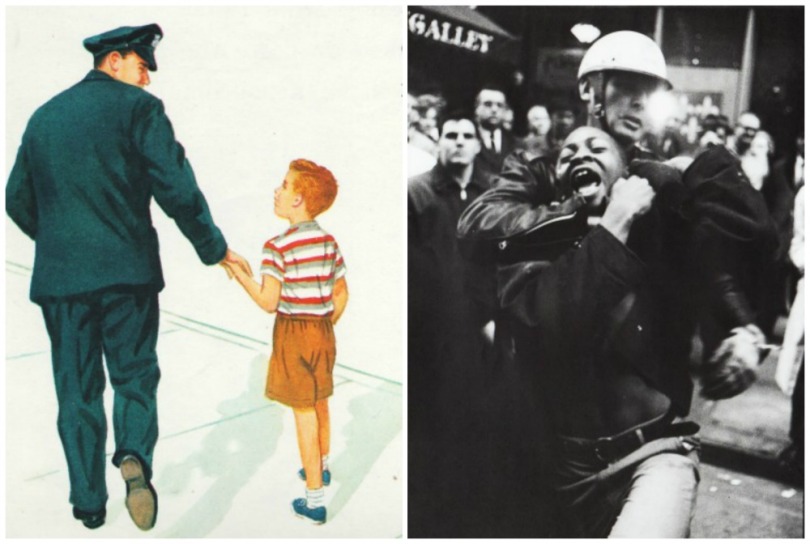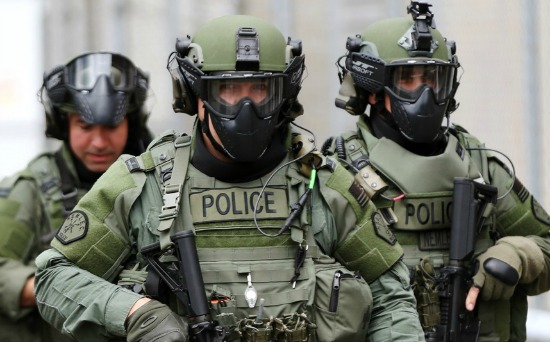A Primer on Police and White Privilege
« Previous
/
Next »
By
sallyedelstein /
December 10, 2014 /
American Way,
History,
Middle Class,
politics,
Race /
31 comments

White children learn early on the policeman is your friend. He keeps us safe.
It is their truth. But the truth is often skewed, as simplistic as these vintage school book illustrations.
The truth is as simple as black and white – the criminal justice system is guilty of treating young black men different from young white men.
If racial identity shapes the way we are treated by police it also shapes the way we are likely to view them.
Disconnects
The all American all white schoolbooks of my own 1960’s childhood served as nothing less than a primer on white privilege.
Without exception, mid-century schoolbooks always presented a heroic picture of police – police officers are the folks who help us when we are lost, keep us safe, protect our homes or who treat us to a thrilling ride in a patrol car in order to show us how exciting it is to be a policeman.

Lessons learned – the policeman is our friend…for some. Even NYC Mayor Bill de Balsio instructed his biracial son to be cautious around police officers. (L) Vintage school book illustration “Stories About Sally” 1956 (R) Photo by photo journalist Danny Lyon 1960s High School student protester
Books with sunny titles like “
Working Together” whose stated purpose was to “Help elementary school children develop a healthy perspective of the job of local law enforcement and enable them to function in their expanding environment.”
Police Keep Us Safe
In “our environment police keep us safe. Friendly police help get our beloved family cat down from the tree, or drive us home to our split level when we are lost.
Is it any wonder we experience police most often as helpful protectors of our lives and property.
But whites don’t see the way blacks often experience law enforcement.
In order to stay safe, black children grow up learning rules for surviving encounters with law enforcement learning how to dress walk and respond to police. Fundamental trust and security of policemen is often just one more thing excluded from a black childhood.
Stories We Tell Our Selves

Sweet Home Alabama. Of course there was never racial disparities in lily white Maplewood, or any of the fictitious towns we visited.
Nothing drove home the gap between what we learned in our schoolbooks more than the civil rights movement which by 1963 dominated the news.
The helpful policemen pictured in our primers who served in these make-believe towns were as interchangeable as the conflict-free towns themselves; friendly, welcoming middle class communities with wholesome names like Maplewood, Greenfield and Brookside.
Red, White and Blue

These wholesome pictures and words stood in sharp contrast to TV nightly news which began showing very different pictures of the world around us.
Mid-century School books like “Our World Around Us” were designed “to help guide children through pictures and stories to appreciate and understand their American heritage,” where truth, justice and fairness as exemplified by law enforcement, were the American way.
But our American heritage was being viewed in a different light
These wholesome pictures and words stood in sharp contrast to TV nightly news which began showing very different pictures of the world around us.
On the same familiar RCA TV that brought us pleasant fictional towns like Beaver Cleaver’s Mayfield (that bore a striking resemblance to our school books), we began seeing real towns like Selma and Birmingham where real American teenagers were clubbed by police for sitting at a Birmingham Woolworths, and police attacked helpless schoolchildren with fire hoses and German shepherds.
Our Friend Policeman Bill…no Bull

The widening disjunction between what we saw on the news and our own school book continued to grow wider. Bull Connor the commissioner of Public Safety for his city of Birmingham Alabam and enforcer of racial segregation who bore no resemblance to Friendly Policeman Bill.
In “Greenfield USA” a book geared to second graders, readers are introduced to “Our Friend Policeman Bill” who keeps the fictitious town safe and sound in 1963. “Policeman Bill,” we are told “is very strong. Helping to keep Greenfield safe is hard work.”
That same year we were also were introduced to infamous Birmingham police commissioner Bull Connor who bore no resemblance to Friendly Policeman Bill.
Burly “Bull” didn’t need to be strong to enforce segregation and keep people safe- he used ferocious dogs and fire hoses.

Two images from 1963 (R) Vintage illustration children’s school book, whose purpose the book explained was “to help children develop a healthy perspective of the job of the local law enforcement. (L) Iconic photo taken in Birmingham in May 1963 when police turned their dogs on demonstrators was taken by Bill Hudson an AP Photographer who covered Civil Rights. The NY Times published the photos across 3 columns above the fold the next day.
Of course there was never racial disparities in Lily white Maplewood, Brookside, Greenfield or any fictitious towns we visited.
The gap between our experience of current events and a world populated by friendly white folks would continue to fracture as the decades wore on.
Our Friend The Policeman-Then and Now
We continue to choke on the artifices and discrepancies. Fifty years later, Our Friend the Policeman seems a distant memory and The Ghosts of Bull Connor seems to have come back to haunts us.
The gap between then and now has only grown wider.

Vintage illustration Children’s school book “Greenfield USA” 1963 Heath Social Studies Series Illustration Tom Hill
Policeman Bill keeps Greenfield safe . His uniform and badge tell people he is a policeman

Policeman Bill Helps Our Children To Be Safe

Vintage illustration Children’s school book “Greenfield USA” 1963 Heath Social Studies Series Illustration Tom Hill
What do you see in the picture that tells you the policeman is a kind and helpful person? Do you think he likes children?

Tamir Rice the 12 year old fatally shot by a Cleveland cop for wielding a toy gun.In order to stay safe Black children learn rues for surviving encounters with the law enforcement Even NYC Mayor Bill de Balsio instructed his biracial son to be cautious around police officers. Black Children are not afforded to same presumption of innocence as white children.
Policemen Protect Our Community

Vintage illustration Children’s school book “Greenfield USA” 1963 Heath Social Studies Series Illustration Tom Hill
Policemen Bill keep our streets safe for all Greenfield

In white America there is an uncritical trust that police are always honest combating criminals lurking in the darkness, roaming our streets risking their lives against thugs. Black parents are always fearful that the next time their child walks out the door may be the last, not because they are lost but because someone or a police officer sees them as dangerous, as disrespectful, as reaching for a gun.
Policemen Keep Our Streets Safe

Vintage illustration Children’s school book “Greenfield USA” 1963 Heath Social Studies Series Illustration Tom Hill
Policeman Bill had to learn how to enforce laws and traffic rules and they learn the best ways to make our streets safe.

Michael Brown the un armed teenager killed by officer Darren Wilson in Ferguson was confronted by Wilson because he was walking in the street “blocking traffic” Brown had his hands up at the time of the fatal shot. Police are more likely to threaten or use force against Blacks at a traffic stop or elsewhere. Blacks are more likely to have their vehicle searched during traffic stops.
Policeman Bill Helps When Things Go Wrong

Vintage illustration Children’s school book “Greenfield USA” 1963 Heath Social Studies Series Illustration Tom Hill
People like Policeman Bill. They think he does a good job.

Protests flared following a Staten Island grand jury decision not to indict NYC policeman whose choke hold and rough arrest killed Eric Garner. The man who recorded the incident, Ramsey Orta was arrested on weapons charge shortly after the video went viral.
Police Training

Vintage illustration Children’s school book “Greenfield USA” 1963 Heath Social Studies Series Illustration Tom Hill
Policemen go to school to learn the best possible methods of protecting life and property

Along with Rampant Racial Profiling stop and frisk the militarization of the police and the demonization of back men have robbed countless non violent offenders their lives and freedom
Police Are Our friendly Helpers

Vintage illustration Children’s school book “Greenfield USA” 1963 Heath Social Studies Series Illustration Tom Hill
The policeman is a good friend and helper in the time of trouble .

If people are hurt Policeman Bill helps them.
#Blacklivesmatter









































